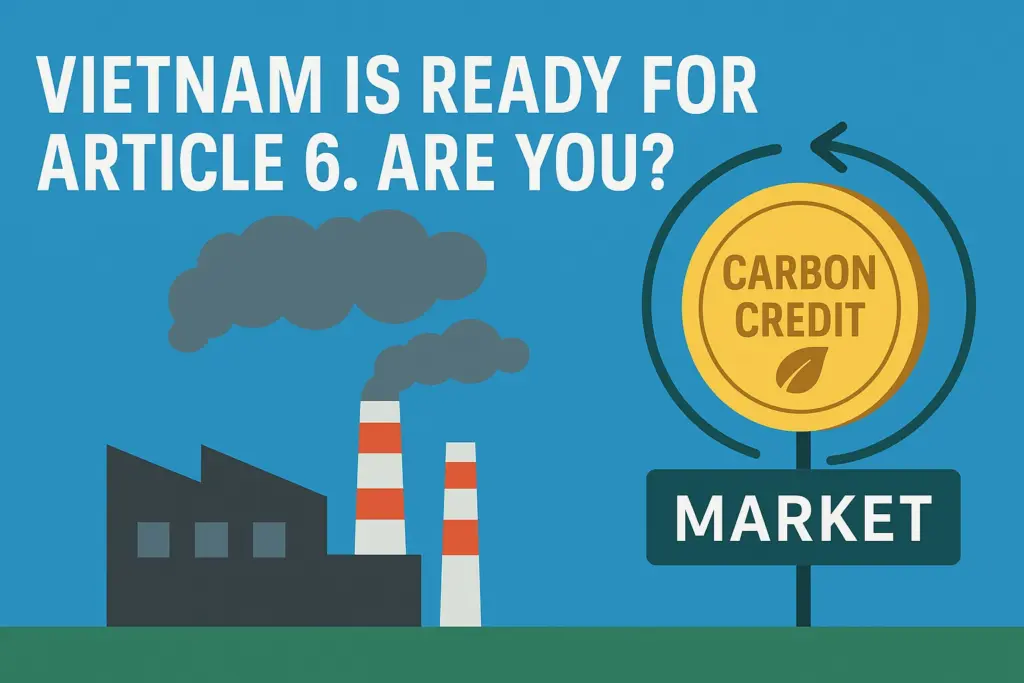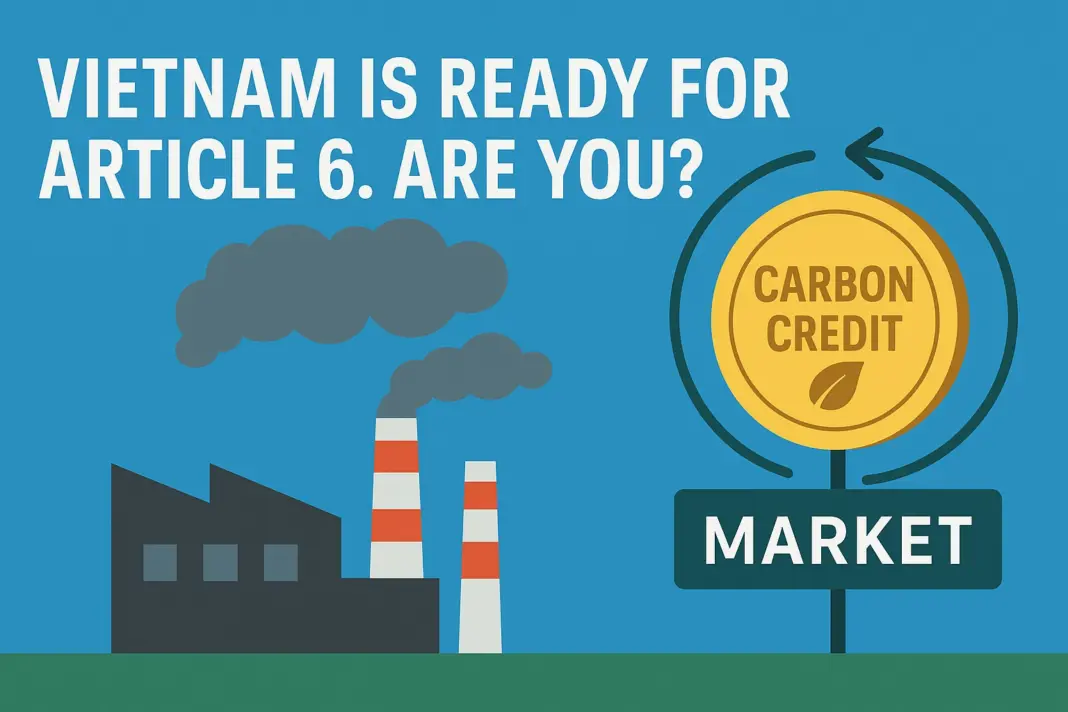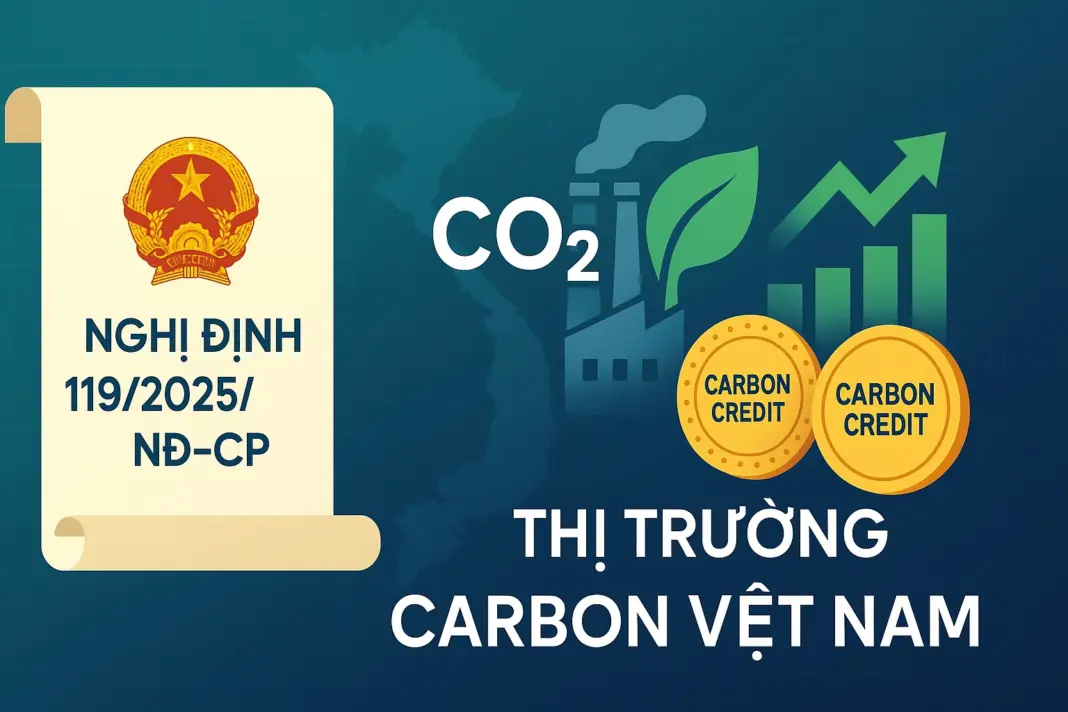Vietnam has recently promulgated Decree 119/2025/ND-CP, formally upgrading Decree 06/2022/ND-CP and clearing the way for a pilot domestic carbon market from June 2025. Decree 119 turns the nation’s “net-zero 2050” pledge into a regulated playing field—with caps, clear rules and a mechanism to export credits. Companies that move now—by auditing their emissions data, standardising MRV, and negotiating Letters of Authorisation (LoA)—will lock in cost advantages and secure early access to ITMOs once the market “opens its floor.”

Vietnam is Ready for Article 6
- Authorisation & Corresponding Adjustment (CA)
The decree mandates that the Ministry of Natural Resources and Environment (MONRE) issue LoAs for transferring mitigation outcomes abroad and update the national registry to implement CAs under Article 6.2. This is a key milestone for investors targeting carbon credit projects traded under Article 6 or CORSIA. - Linkages with International Mechanisms
Eligible credits may originate from the CDM, Japan’s JCM, Article 6.4, or bilateral schemes such as Singapore–Vietnam and Switzerland–Vietnam, enabling domestic projects to “convert” into ITMOs the moment the market launches. - Clear Roadmap
2025-2028: pilot ETS (largely free allocation so firms can familiarise themselves); from 2029: auctions and coverage expansion to transport and commercial buildings. The decree is fully aligned with Decision 232/QD-TTg and the Government’s carbon-market roadmap.
What Should Companies & Investors Do Now?
| Priority Area | Recommended Actions |
| Emitting companies (cement, steel, coal-fired power) | Complete a 2024 emissions inventory as a baseline; craft a buy/sell strategy for allowances & credits; invest early in internal abatement projects to exploit the 30 % offset quota. |
| Carbon-project developers | Align methodologies with JCM or Article 6.4; prepare LoA dossiers under the new template; prioritise projects with strong SDG co-benefits to attract capital. |
| Investment funds & financial institutions | Build a pipeline of ETS-fit projects (energy efficiency, waste, renewables); assess allowance-price risk for 2025-29; negotiate ITMO pre-purchase deals with project owners. |
| Partner Countries | Engage MONRE and the Hanoi Stock Exchange (carbon-exchange operator); develop bilingual CA-audit criteria; roll out JCM projects or bilateral ITMO-swap contracts. |
Investment Opportunities for Carbon Credits Across the Economy
Energy (power & renewables)
Energy is the largest emissions source yet the richest in abatement potential. Carbon credits will boost the economics of wind, solar, hydropower and other renewables, while coal and gas plants that exceed caps must purchase credits—creating a strong incentive to upgrade technology or transition to clean energy. Vietnam aims for 45 % renewables by 2050, backed by generous incentives.
Agriculture
Rice cultivation and livestock emit significant methane. The carbon market enables low-emission agriculture projects—“nature-positive” rice in the Mekong Delta, biogas digesters, organic fertilisers, alternate wetting–drying rice, etc.—to earn tradable credits and new income streams. Pilot low-carbon rice schemes in Dong Thap and An Giang will have clear credit off-take routes once the market is live.
Forestry (afforestation & forest protection)
Forests are a classic “green credit” source. Decree 119 prepares methodologies for sustainable forest management, afforestation and improved forest quality, paving the way for large-scale REDD+ and tree-planting programmes. Investors can finance reforestation, agro-forestry or forest restoration and earn credits from additional CO₂ uptake. Existing schemes—PFES and the World Bank’s US$ 51.5 million reforestation project—will become even more attractive when their credits can be traded.
Heavy Industry (steel, cement, chemicals)
These sectors face direct caps from 2025. Plants that cut emissions per unit—via advanced tech or cleaner fuels—can sell surplus allowances; laggards must buy allowances or credits. This drives investment toward low-carbon technologies such as green-hydrogen steel or low-clinker cement. Major Vietnamese players are already preparing: Hoa Phat is trialling waste-heat power, chemical giants are greening production, and VinFast is betting on EVs. Domestic and foreign funds can target industrial firms with credible decarbonisation plans, reaping dual benefits—lower compliance costs and revenue from surplus credits or green finance incentives.
Beyond these sectors, the market will spur financial-services and cleantech growth. Demand for emissions verification and carbon auditing will surge, benefitting consultancies and assurance firms. Banks can roll out carbon-credit finance products, while carbon-credit funds and emissions-reduction start-ups gain fertile ground under the clarified legal framework.
The Vietnamese carbon market is projected to reach billions of US dollars annually. With a starting carbon price of roughly US$ 5-15 per tonne, the market could hit US$ 1 billion by 2030. Vietnam is also exploring regional links—potentially connecting to China’s market or the Asian Carbon Exchange—further boosting liquidity and helping domestic exporters avoid carbon border taxes like the EU’s CBAM from 2026.
How Should Companies and Funds Prepare?
With the legal architecture in place, carbon should be treated as a new “asset class.” Large emitters must measure and inventory their GHGs, craft compliance plans, and invest early in clean technology to sell surplus credits later. Low-emission or already-green firms can enter the market as credit sellers, creating extra revenue streams.
For investment funds and financial institutions, the carbon market unlocks a fresh channel into mitigation projects and climate tech. Trading carbon credits can diversify portfolios, but funds must also manage price risk and meet stricter ESG reporting standards.
Decree 119/2025/ND-CP is a watershed in Vietnam’s climate policy, converting lofty goals into tangible market mechanisms. The coming years will see a vibrant Vietnamese carbon market—simultaneously exerting decarbonisation pressure and opening new business and investment opportunities. Observers believe that, if executed well, the market could become a powerful financial driver, helping Vietnam cut emissions 27 % by 2030 and reach net-zero by 2050. Early movers will capture the competitive edge and help shape a greener future for Vietnam.
Thị trường Carbon







